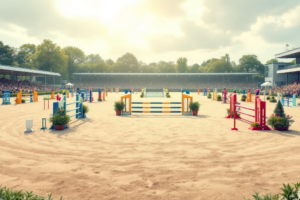From Ancient Greece to Versailles: The Evolution of Equestrian Sports at the Olympic Games.
July and August have all been about Olympic fever. And rightly so. It’s the pinnacle of sport.
The one medal every athlete craves and every young aspirational child dreams about. Even though by the time you get to read this article the Games may be over, we thought it would be a perfect opportunity to walk through the Equestrian Olympic sports and the history of how we are following the format we are today. In ancient Greece, you would have been hard-pressed to see a piaffe. Instead, because the inclusion of equestrian events in the Olympics dates back to the ancient Greek Games around 680 BC, chariot racing would have been the prominent event. But we have the ancient Greeks to thank; it was this early association between horsemanship and competition that laid the groundwork for the modern equestrian disciplines we see today.
The Sport We Know, In the modern era, equestrian sports made their Olympic debut at the 1900 Paris Games, featuring events like the high jump, the long jump, and the now-discontinued polo competition. However, it wasn’t until the 1912 Stockholm Games that the current equestrian disciplines of dressage, show jumping, and eventing were established. These three disciplines have become the cornerstone of Olympic equestrian competition, each testing different aspects of the horse-rider partnership: precision in dressage, agility in show jumping, and versatility in eventing. A significant milestone in Olympic equestrian history occurred in 1952 when women were allowed to compete alongside men. This was first seen in the dressage event (1952), followed by show jumping in 1956 and eventing in 1964. The inclusion of female athletes marked a progressive shift, as equestrian sports became one of the few Olympic events where men and women compete directly against each other and on the same teams.
The Federation Equestre Internationale (FEI), established in 1921, has played a crucial role in the development and regulation of equestrian sports globally. Today the role the FEI plays is that it ensures that competitions adhere to standardised rules, promoting fair play and the welfare of the horses involved. Over the years, advancements in training, equipment, and veterinary care have elevated the standards of competition, making equestrian sports a captivating and technically demanding discipline.
The Modern Discipline, Equestrian sports in the modern Olympic Games comprise three main disciplines: Dressage, Show Jumping, and Eventing. Each discipline showcases unique aspects of the horse-rider partnership, combining elements of skill, agility, and endurance.
Dressage – Dressage, with its roots in ancient Greek military training, became an Olympic sport in 1912.
Show Jumping – Introduced to the Olympics in 1912, the jumps can reach heights up to 1.65 meters and spread up to 2 meters.
Eventing – The “equestrian triathlon,” includes Dressage, Cross-Country, and Show Jumping. This discipline made its Olympic debut in 1912.
The show jumping classes have seen some of the most memorable Olympic moments, such as Captain Alberto Larraguibel’s record-breaking jump of 2.47 meters in 1949, which still stands as the world record.
Versailles as the Venue, The Palace of Versailles, a UNESCO World Heritage site, was selected as the venue for the equestrian events at the 2024 Paris Summer Olympics. This iconic location, known for its opulence and historical significance, provided a stunning backdrop for the competition.
Versailles has a long history of association with horses, dating back to the time of Louis XIII and Louis XIV, who transformed the site from a hunting lodge into a grand palace. The grounds of Versailles were integral to the daily life of the court, with the Grand and Small Stables playing a crucial role in housing horses for war, hunting, and ceremonial purposes. This historical connection made Versailles a fitting location for showcasing the elegance and skill of Olympic equestrian sports. The equestrian events have taken place across several specially prepared sites within the palace grounds. A temporary 16,000-seat outdoor arena was constructed on the Étoile Royale esplanade, adjacent to the Grand Canal. This setting offered a unique viewing experience, with the arena bordered by three grandstands and an open-ended section overlooking the canal and palace facade. Both the dressage and show jumping took place here, while the cross-country phase of the eventing unfolded along a 5.3 km course near the Grand Canal. Can you just imagine galloping through the ground of Versailles? It’s definitely a once-in-a-lifetime opportunity for a very exclusive and elite group of athletes.
Dream Big to Make It, From the grace and precision of Dressage to the exhilarating jumps in Show Jumping and the endurance challenges in Eventing, each discipline brings its own unique excitement to the Olympic Games. The Olympic Games have been instrumental in elevating the status of equestrian sports, providing a global stage for riders and horses to showcase their talents and take home gold!.

















